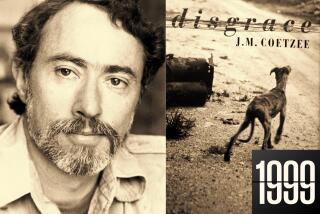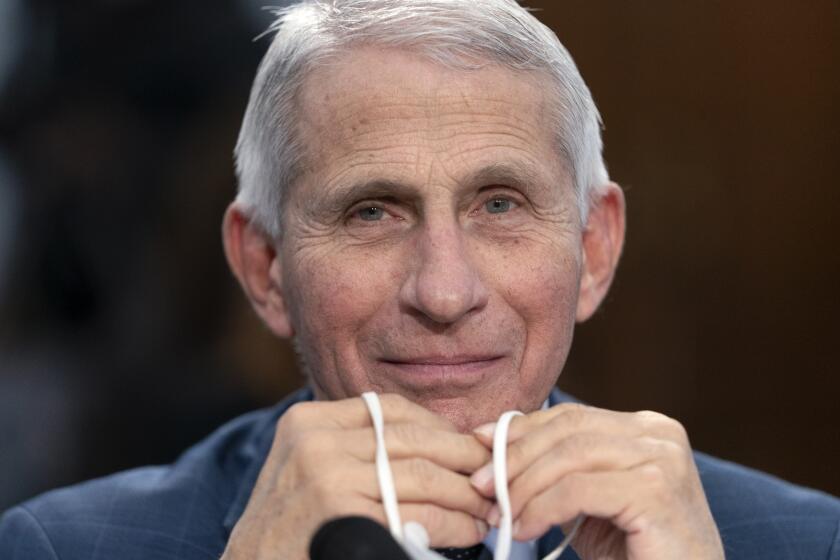‘Death From the Sky’
Everest seems to have poisoned many lives.
--From the book “Into Thin Air”
*
At this moment, the airline has lost his luggage. The climactic slide for tonight’s public slide show was left in Texas. He is at the end of a grueling, 32-city book tour, and this is his last interview.
The real turmoil, though, has been longer in the making. And Jon Krakauer still hasn’t had time for proper reflection on the indelible changes in his life after a single disastrous encounter with Mt. Everest.
So he can only express what it feels like now: A paradox that mountaineers around the world already know well. In May 1996, putting at risk everything he cherished, Krakauer struggled to the summit of the world’s highest mountain. Now his splendid book about the climb, “Into Thin Air” (Villard), has risen to the bestseller lists.
“Damn it, these are things you dream about. So why can’t I enjoy it?” he asks rhetorically.
Answer: Because while Krakauer was up there, a sudden storm engulfed the great mountain and nine people died. In his own party, five got to the top. All perished except for Krakauer. His closest friend on the team died. The lead guide on his trip died, pinned down in a blizzard at 28,700 feet; his last words were to his wife via satellite phone: “I love you. Sleep well, my sweetheart. Please don’t worry too much.”
Says Krakauer, “I can’t enjoy it because I think, yeah, I lived. . . . And I was party to those deaths. Survivor’s guilt. It was something I never had insight into before. It’s a real gumbo of emotions.”
The world of high-altitude mountaineering has always divided people into those who understood the whys and those who could not. But now, even those who understand find themselves rethinking the purpose and practices of one of humankind’s riskiest endeavors. And thanks in large part to Krakauer’s writing and public speaking, many thousands of armchair adventurers have also joined in the debate.
What has changed on Everest is not the desire for conquest, but the definition of who should take on the challenge. For a long time, it was a world reserved for experts. A long alpine apprenticeship proceeded a climber’s invite to join a Himalayan expedition.
That changed in the mid-1980s, when two 50-ish American businessmen, Dick Bass and Frank Wells, set out to do what had never been done: climb Everest and the highest peaks on the six other continents.
In their book, “Seven Summits” (Warner Books, 1986), the two conceded they had “so little climbing experience they could hardly be ranked amateur.” Forget apprenticeship, the two wealthy men would employ guides to lead the way.
“Before that, mountaineering still felt like a club--a small, idealistic subculture with a rigid set of ethics. . . . It wasn’t like skiing or windsurfing, it was a calling,” says Krakauer, who spent his early years following that calling.
By the 1990s, all sorts of what Krakauer calls “Walter Mitty guys” were enticed to try Everest behind guides. Costs ran to $65,000 apiece. The highest peak in the world was now in the grasp of more ordinary mortals.
“It’s warped, it’s sick. But there’s still something noble in it. That old ‘reaching for the stars’ crap,” Krakauer says.
In 1996, Outside magazine sent Krakauer along on one such guided expedition to inquire about the trend. Although experienced, Krakauer considered himself one of these Walter Mitty guys--growing up in Oregon where his father was friends with one of the most celebrated Everest climbers of all, Willi Unsoeld.
So, naturally, Krakauer was drawn to the club, the calling of climbers. His specialty became technical climbing, in which rocks and ice were the challenge more than merely altitude. He made some notable ascents but had never taken on one of the Himalayas’ big peaks. He did, however, daydream of himself on that sublime wedge of windblown ice at 29,028 feet on the border between Nepal and China.
In a recent review for The Times, I described “Into Thin Air” as a classic. Krakauer captured not only the breathless drama and agonizing banality of mountaineering, but its abundant paradoxes. Now, in his West Hollywood hotel suite, he raises another paradox--perhaps the one at the heart of his troubled mood:
The conflicting roles he played as journalist and climber, of climber and client, when things went bad.
In other words, Krakauer became the very story he set out to observe: How money and guides have changed the ethic of mountaineering.
He went to Everest as a writer and client. By his own admission, “I didn’t belong on Everest.” But once there, the old instincts took hold and he reverted to climber.
He would get a story, sure, but what he really wanted was the summit. Mountaineering, after all, was what got him started as a writer. His first stories were commissioned by climbing magazines. Climbing had always been of a higher order. “I will risk my life for a climb. I wouldn’t risk my life for a story.”
Later, of course, he returned home more celebrated as a writer than he is ever likely to be as a climber. His cover story for Outside in September 1996 made it the best-selling edition in the history of the magazine.
*
In between being writer and climber, disaster lurked. On May 10, 1996, Krakauer took all the risks and got to the top. A whole series of small troubles, though, had laid a trap for his team. The approach to the top of the mountain was too crowded, and climbers were bottlenecked. A rope had not been fastened into place when it should have, perhaps because a Nepalese Sherpa guide was preoccupied helping pull a wealthy client toward top. A plan to turn back at a set time seemed to evaporate. And some key guides and climbers were suffering more than expected from the debilitating effects of high altitude.
Then the storm rolled in, an ordinary kind of storm--100-mile-an-hour winds, 70-below temperatures--Krakauer was already on his way down. He passed one of the guides, who was acting erratic. If this had been an old-fashioned team expedition, Krakauer might have felt obliged to intervene forcefully. But these were not climbing partners. One was a client and the other the “invincible guide,” as Krakauer remembers.
“Guiding on Everest runs counter to all the values of climbing that I believed in: Self-reliance, loyalty to a team and rabid idealism. I chafed at it all during this climb . . . but when it was expedient, I said I was only a client. That’s what eats at me.”
Krakauer continued down the mountain and the guide ultimately perished. Making things worse, the family of another guide who died that day has severely criticized Krakauer.
*
As he speaks, Krakauer gazes at the ceiling or at the wall. Only once in a while does he make eye contact. It is an uncomfortable scene.
I ask him to respond to two quotations:
It is not in giving life but risking life that man is raised above the animal. --Simone de Beauvoir
It is only by risking our persons from one hour to another that we live at all. --William James
“I subscribe to those ideas, but I don’t usually admit it in public,” Krakauer responds.
Risk has always been the essence of climbing. Everest has claimed at least 154 lives, including 12 last year and seven this year. Slightly more than 700 have made the top--exactly how many is unknown because some have disappeared while headed up. No one knows if they made it before they perished. Work out the math: One person has died for every five who reached the summit.
Krakauer points to his laptop computer on a desk in his room. Just before this interview, he was scanning Everest Web sites. At one, a long and furious debate was underway about this very notion of risk as incentive.
“If it wasn’t risky, it wouldn’t be worth doing,” says Krakauer, accepting one side of the argument. Then he stops and looks again at the ceiling to reflect on the other side of the debate. “But it seems so hollow and fatuous to say that when 12 die.”
When he returned home from Nepal, Krakauer brought the personal effects of one dead climber and gave them to the man’s anguished family. “To read quotes about risk to them would be obscene,” he says.
Like any author on an extended book promotion tour, Krakauer gets a standard array of questions. Among them:
What’s it like on Everest? “It’s like outer space. Your surroundings are quite barren, harsh and austere. The thick down clothes you wear make you as clumsy as you’d be in a space suit. Also, you’re breathing oxygen from cylinders for life support.”
What would he say to someone contemplating a guided trip? “I’d say, ‘Are you prepared to lose your life?’ ”
Will he ever go back?
“Not to climb. But I will go back to base camp in two or three years, maybe sooner, in the off-season just before the monsoon and think about some things. But not to climb. To me, climbing was always something where risk was a matter of maintaining control. You could control your fate. But not Everest. There it was like war with random incoming. A malevolent force. Death from the sky.”
What next?
“People say, ‘Why don’t you let go?’ They don’t understand that I haven’t had a chance to let go. I need that chance. . . . I don’t know how I’m going to deal with things in the end. People don’t appreciate that. But since Everest, it’s been writing and researching, and now this book tour where you’re talking about it every day. . . .
“At some point when this is over, I’ll put it aside and then come back and see where I am. Because I don’t know where I am. I hope that things get better. People say, ‘Hasn’t the book been cathartic?’ I just don’t think the world works that way, where you write a book or see a shrink and things get better. In the real world, you make mistakes, and you pay.”
More to Read
Sign up for our Book Club newsletter
Get the latest news, events and more from the Los Angeles Times Book Club, and help us get L.A. reading and talking.
You may occasionally receive promotional content from the Los Angeles Times.






